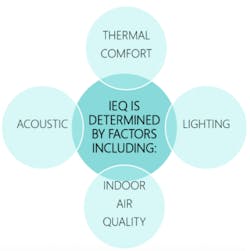Breaking Down Indoor Environmental Quality (IEQ) and How to Improve It
Health and wellbeing of occupants in workplaces are directly affected by the built environment that defines indoor environmental quality (IEQ). IEQ is a measure of several different indoor parameters, including but not limited to:
- Indoor air quality
- Interior thermal comfort
- Interior light quality
Indoor Air Quality
Indoor air quality constitutes of various factors like temperature, relative humidity, presence of VOCs (such as formaldehyde and acetaldehyde) and dangerous gases (such as COx, NOx and SOx). Poor air quality leads to various health symptoms of the occupants, which can include inflammation of the eyes and respiratory system, headaches and tiredness, inability to concentrate, nausea and related loss of productivity, according to a research paper presented at Healthy Buildings 2003.
A 1989 report published by EPA identified that improved indoor air quality in workspace environment can not only help occupants to achieve higher productivity but also result in fewer lost workdays.
The research report in the June 2016 issue of International Journal of Sustainable Built Environment found that the two most common strategies adopted to improve air quality are:
- Increasing ventilation rate
- Reducing the source of pollution within and outside the building
Interior designers play a prominent role in improving air quality through efficient design and appropriate choice of interior finishes and furniture. Recent increase in the adoption of green building guidelines have considerably helped with the air quality issues by using low polluting building material and installing effective air handling systems.
Interior Thermal Comfort
Thermal comfort, yet another of IEQ parameters, influences occupant health and comfort. Studies suggest strong correlation between thermal comfort and occupant productivity in a workplace environment. However, ecological and demographic factors such as geographic location and climate, time of year, gender, race and age have strong correlation with thermal acclimatization of occupant which further influences thermal comfort.
As defined by ASHRAE Standard 55 (2004), thermal comfort is “that condition of mind which expresses satisfaction with the thermal environment.” To achieve thermal comfort, six primary factors are addressed during the design of a workplace and selection of an air handling system:
- Metabolic rate of occupants
- Clothing insulation
- Ambient air temperature
- Radiant temperature
- Air speed
- Humidity
It’s important to address the specific thermal comfort needs for a building from its early design stage, as sometimes the alteration of structures post-construction is inefficient and expensive.
Interior Light Quality
Interior lighting, an important IEQ parameter for workplace, is the use of either natural or artificially converted light energy to provide desired visual environments for workspaces. Human eyes are generally attracted toward light, a unique human behavior called phototrophic behavior (most predominant in moths). Studies have shown that light not only attracts people, but can actually change the path of about 40% of a crowd with directional change in light intensity, as noted in Display Lighting Preferences report in the Journal of the Illuminating Engineering Society.
Inappropriate lighting systems can affect occupants’ natural circadian rhythms and hormonal patterns, thus impacting comfort level. Light with high luminous intensity helps perform very complex and intricate visual tasks accurately and without much fatigue, according to a report found in the Journal of Architectural Engineering. As designers, the key purpose of providing appropriate interior lighting is not only for better visual effect but also for health and comfort of its occupants.
Read Next: noho Eco-Friendly Flexible Furniture
About the Author: Suchi Bhattacharjee is an Associate Professor of Interior Design at University of Oklahoma with an area of interest in sustainability and indoor environmental quality. She holds a doctorate degree in Environmental Design and Planning and MS degree in Building Construction from Virginia Tech after completing her bachelor of Architecture degree from India.
